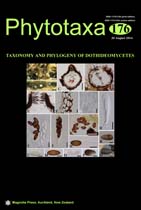Abstract
The family Myriangiaceae is relatively poorly known amongst the Dothideomycetes and includes genera which are saprobic, epiphytic and parasitic on the bark, leaves and branches of various plants. The family has not undergone any recent revision, however, molecular data has shown it to be a well-resolved family closely linked to Elsinoaceae in Myriangiales. Both morphological and molecular characters indicate that Elsinoaceae differs from Myriangiaceae. In Elsinoaceae, small numbers of asci form in locules in light coloured pseudostromata, which form typical scab-like blemishes on leaf or fruit surfaces. The coelomycetous, “Sphaceloma”-like asexual state of Elsinoaceae, form more frequently than the sexual state; conidiogenesis is phialidic and conidia are 1-celled and hyaline. In Myriangiaceae, locules with single asci are scattered in a superficial, coriaceous to sub-carbonaceous, black ascostromata and do not form scab-like blemishes. No asexual state is known. In this study, we revisit the family Myriangiaceae, and accept ten genera, providing descriptions and discussion on the generic types of Anhellia, Ascostratum, Butleria, Dictyocyclus, Diplotheca, Eurytheca, Hemimyriangium, Micularia, Myriangium and Zukaliopsis. The genera of Myriangiaceae are compared and contrasted. Myriangium duriaei is the type species of the family, while Diplotheca is similar and may possibly be congeneric. The placement of Anhellia in Myriangiaceae is supported by morphological and molecular data. Because of similarities with Myriangium, Ascostratum (A. insigne), Butleria (B. inaghatahani), Dictyocyclus (D. hydrangea), Eurytheca (E. trinitensis), Hemimyriangium (H. betulae), Micularia (M. merremiae) and Zukaliopsis (Z. amazonica) are placed in Myriangiaceae. Molecular sequence data from fresh collections is required to confirm the relationships and placement of the genera in this family.

